How To Install Dishwasher Drain To Double Sink
An improperly installed dishwasher drain hose is the nearly common defect we find with dishwasher installations, but it's also one of the easiest things to go correct.
In the photo below, which was featured as a Structure Tech Photo of the Day on our Facebook page, there are several plumbing defects shown. 2 of these are related to the dishwasher drain.
Can you spot them?
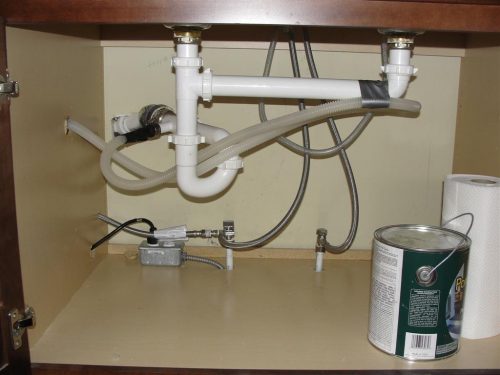
Wrong side of the trap
The commencement trouble is the dishwasher drain is connected to the sewer side of the trap. Water ever sits in the bottom of the P-trap, and this prevents sewer gases from coming into the house. The dishwasher drain must exist connected earlier the P-trap, notsubsequently information technology, which is what was done here. With this improper installation, sewer gases take the potential to come back into the dishwasher. The diagram below correct shows a proper installation.
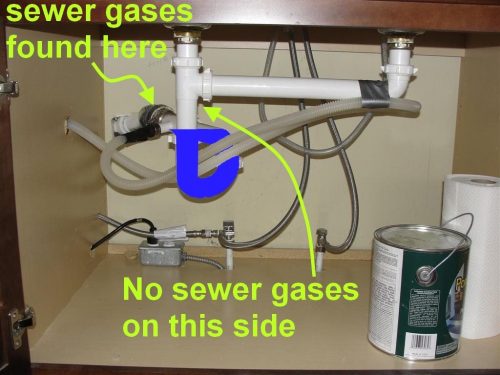
The diagram below right shows a proper installation.
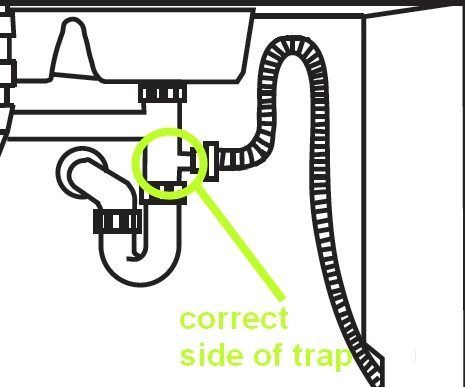
No high loop
In the diagram above, you'll discover that the dishwasher drain makes a high loop underneath the kitchen sink. This is the minimum requirement for every dishwasher drain installation; it's required by every dishwasher manufacturer, as well as section P2717.two of the International Residential Code. Even so, that's not what we require here in Minnesota. Hang on, I'll come back to that in a infinitesimal. Simply first, here'southward a photo showing what a high loop looks similar.
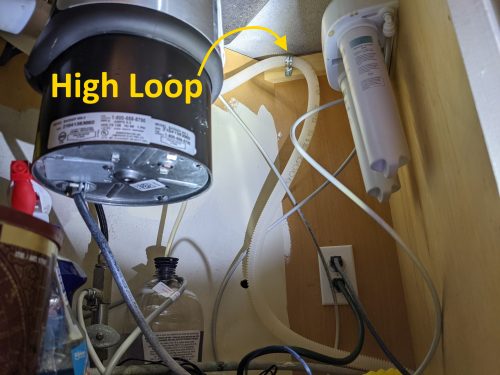
As you can see, the dishwasher drain hose is fastened as high equally possible underneath the counter. And here'southward a diagram from the dishwasher manufacturer showing the same matter.
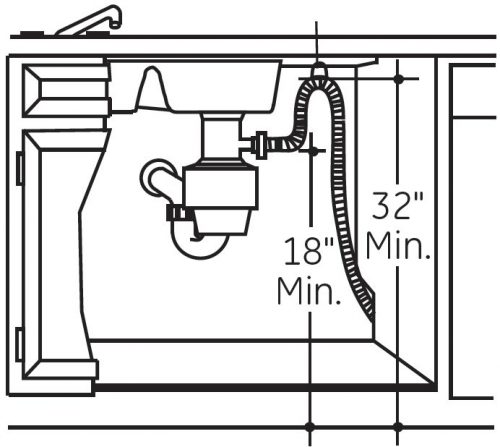
Although new dishwashers come from the manufacturer with the drain looped upwardly at the side of the dishwasher, every installation manual nevertheless requires this high loop underneath the sink.
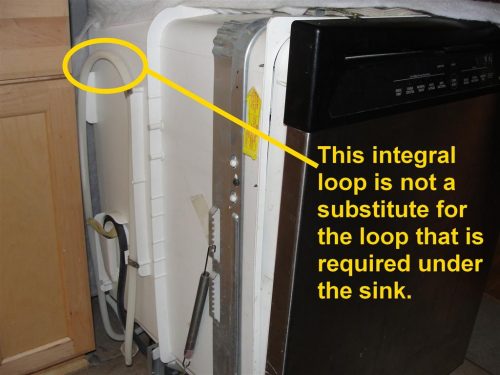
I've heard dissimilar reasons for why an additional loop is required under the sink, so I decided to contact the manufacturers directly.
I sent out an electronic mail to 8 dishwasher manufacturers about a decade agone asking them this question:
"A high loop is required on the dishwasher bleed i n the installation instructions for all of your dishwashers . What is the purpose of this? Doesn't the high loop that is incorporated into the side of the dishwasher achieve the same thing? Whatsoever insight or commentary into this matter would be greatly appreciated."
Here are the responses I received:
- Kenmore: "The high loop or air gap must be used to prevent potential backflow contagion of the dishwasher. Local plumbing codes generally dictate the requirements in your area. Department 807.4 of the Compatible Plumbing Code states: "No domestic dishwashing motorcar shall be directly connected to a drainage system or nutrient waste disposer without the use of an approved dishwasher airgap fitting on the discharge side of the dishwashing car. Listed airgaps shall be installed with the inundation level (FL) mark at or in a higher place the alluvion level of the sink or drainboard, whichever is higher, or separately trapped with the airbreak located on the stand up pipe."
- GE: "If an air gap is not required, the drain hose must take the high loop from the flooring to prevent backflow of water into the dishwasher or water siphoning out during operation."
- Bosch: The loftier loop in the bleed hose of your dishwasher is to keep water from settling in the hose if information technology were hanging down any lower or horizontally. This keeps the drain hose dried out and keeps any odors from backing up into the dishwasher.
- Viking: In testing our dishwashers, nosotros have found that the additional high loop in the back of the dishwasher is required for proper draining of the water. Nosotros have seen when this slice is not applied that over time the consumer volition have issues with the water support and causing bug with proper drainage and water pooling in a particular surface area.
- Maytag: No response.
- Whirlpool: No response.
- Amana: No response.
To summarize, the reasons for the loftier loop are to prevent potential backflow of water into the dishwasher and to forbid improper drainage of water. Even though dishwashers come up from the factory with the drain looped up high against the side of the dishwasher, this is not an acceptable substitute for the high loop underneath the kitchen sink. In Minneapolis, the lack of a properly installed high loop under the kitchen sink requires repair for their Truth-In-Sale of Housing evaluations. If you lot don't accept a loftier loop on your kitchen sink drain, it'll have iii items to fix this: a screwdriver, a screw, and a three/4″ EMT clamp, which you'll find in the electrical department of any domicile improvement store.
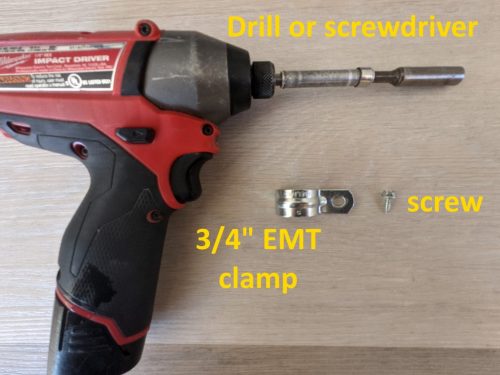
The video at the beginning of this post shows the process for fixing this, which takes virtually 10 seconds.
What almost air gaps?
Instead of a high loop underneath the kitchen sink, dishwasher manufacturers besides allow an air gap. This consists of an ugly device mounted on top of the kitchen sink, and it looks like this:
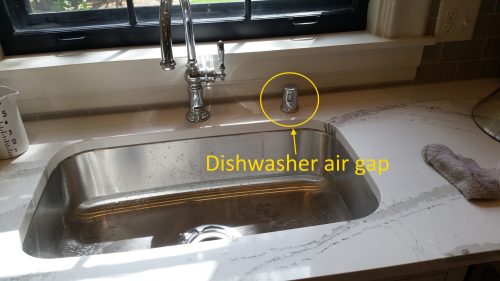
These take been required in Minnesota since the beginning of 2016, and nobody likes them. I blogged nigh dishwasher air gaps dorsum in 2017, and I'yard going to quote what I said back then. Dishwasher air gaps are definitelynot something that we recommend installing during our home inspections. While dishwasher air gaps are technically required on new installations by code, we're not lawmaking-compliance inspectors. As abode inspectors, we get to make recommendations on stuff that makes sense to usa. These don't.
The corking news is that air gaps should be going away shortly, at least in Minnesota. Our current plumbing code requires an air gap through sections 414.3 and 807.iv of our plumbing lawmaking. Thankfully, the side by side version of our plumbing lawmaking, scheduled for adoption on 12/17/21, will change that. Section 414.three volition tell yous to follow section 807.three, and that section will say the following:

I underlined the important part that's changing. Yay. Homeowners, plumbers, builders, designers, edifice officials, and everyone else should be happy about this change. Well, anybody except for air gap manufacturers. Sorry guys, only you had your day.
Update 12/17/21:Dishwasher air gaps are no longer required on residential installations.
Source: https://structuretech.com/dishwasher-drains/

0 Response to "How To Install Dishwasher Drain To Double Sink"
Post a Comment